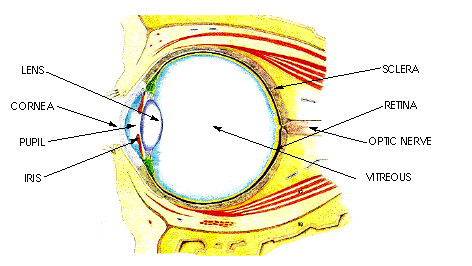The sclera (the "white") surrounds most of the eye and gives it its structural strength. In the front of the eye is the cornea, a window of transparent tissue which protrudes slightly from the sclera. Just behind the cornea, and easily visible through it, is the iris, which is the part of the eye with the characteristic brown, blue, hazel, or green colour. There is a circular hole, the pupil, in the centre of the iris. It appears black, because the interior of the eye is designed to absorb light, not to emit it.
The light passes through the cornea into the aqueous body, which is simply a cavity filled with fluid. From there, passing through the pupil (which, as you remember, is a hole in the iris), the light passes through the lens, then the vitreous body, before striking the retina. The vitreous body is similar to the aqueous. The retina is like a projection screen, or like the film of a camera.
The retina then processes the light and translates the information into a form suitable for electrical transmission along the optic nerve. This leads, of course, to the brain, which finishes off the job of processing and interpretation.

Clear vision is achieved only if light from an object is well focused onto the retina. Most of the focusing power is provided by the cornea, but every time light goes from one kind of transparent material to another (cornea to aqueous, aqueous to lens, lens to vitreous), the light is bent slightly. The overall focusing power is fine-tuned by adjusting the shape of the lens. This is accomplished, usually unconsciously, by the contraction of tiny muscles which make the lens bulge slightly. This is known as accommodation. The more accommodation, the closer are the objects on which the eye can focus.
In an emmetropic eye (that's just a fancy way of saying an eye that focuses normally), the most distant objects are seen clearly when the focusing muscles are relaxed. Near objects are seen by accomodation, as described above. In a typical young, healthy eye, this near focusing is achieved easily. As an eye ages, the lens stiffens, making it more difficult to adjust its shape to focus on nearer objects. This condition (presbyopia) is usually dealt with by the use of reading glasses.
Normal, emmetropic vision requires a kind of harmony in the overall shape and size of the eye. There are many relevant geometric variables, including the length of the eye, the curvature of the cornea, the thickness of the lens, and others. For normal vision, all of these parameters must work together. All else being equal, a larger eye requires a flatter cornea, and a smaller eye requires a more curved cornea.
If your cornea is too curved, the result is myopia, or nearsightedness. A myopic eye cannot see clearly in the distance without the aid of a corrective lens. With even a mild case of myopia, you may not be able to focus on anything beyond arm's reach. With a more serious case, you may not be able to focus on anything more than a few inches past your nose, and you may be unable to recognize your mother across a room.
The opposite problem is hyperopia, or farsightedness, which results from a cornea which is too flat. A mildly hyperopic eye without corrective lenses must accommodate (see above) to some extent to focus on distant objects, and must accommodate even more to focus on near objects. Such a case may go unnoticed, especially in a younger person for whom accommodation is easy; but the eye may tire quickly, since accommodation must happen more frequently and to a greater degree than in an emmetropic eye. Also the ability to focus on near objects without corrective lenses will likely be lost at an earlier age than in an emmetropic eye, and eventually corrective lenses may even be needed to focus on distant objects.
A more serious case of hyperopia may make it impossible for even a young eye to focus on anything without corrective lenses. Some people with severe hyperopia think they must be nearsighted because they cannot see in the distance, but in reality the problem is that even the most distant objects are too close!
A normal cornea is round, like a volleyball. But many corneas are shaped more like a rugby ball or a North American football. The result is astigmatism, another common refractive disorder. Many myopic or hyperopic eyes are also astigmatic.
An astigmatic eye cannot focus perfectly on any object without corrective lenses. So, for example, an eye with both myopia and astigmatism will see distant objects very badly, and will see near objects much better, but still not perfectly.
For older people, there are other considerations, since the ability of their eyes to accomodate is more limited.
Bifocals are an option for spectacle wearers with presbyopia. The upper portion of the spectacle lens is designed for distance vision and the lower portion for near vision. This allows both far and near objects to be seen without accomodation, each through the appropriate part of the spectacle lens.
Another option for presbyopes is monovision, which can be achieved with spectacles or (more commonly) with contact lenses. One eye is corrected for distance vision and the other for slightly nearer vision. This lessens the effect of presbyopia in that it expands the range where at least one eye can see clearly. But as presbyopia advances, a different amount of correction will still be needed for reading.
There are several kinds of laser refractive techniques available for correcting myopia, hyperopia, and astigmatism. As with corrective lenses, the ideal objective is usually to make the eye emmetropic, but monovision is an option for presbyopes.